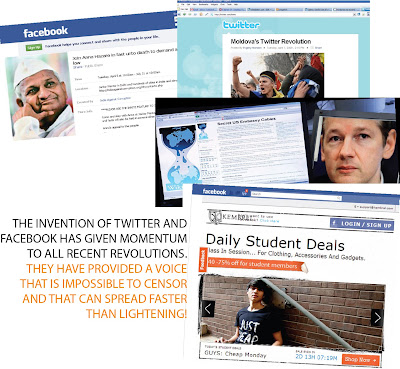The humble handset
If you thought that your humble cell phone was just that, perish the thought. It is the global lifeline for cultural, economic and social change. From social change to social networking, everything is happening on the quintessential mobile phone
“A man, a young surfer, receives a call on his cell phone. A woman’s voice on the other side tells him that she has been kidnapped and her husband and son, along with her would be killed. She has no clue where she is. He is her only lifeline. The cell phone battery might go dead soon, so would her chances of survival.”
That’s a snippet from the very engrossing thriller movie Cellular. You need to watch it to know what finally happened to Jessica Martin (the woman who called) and whether the young man could rescue her by using his mobile and nothing else. But today mobiles are doing much stranger and fantastic things than just rescuing kidnapped women.
Changed economics
Ozwald Boateng is the famous British designer who is credited with introducing ‘tailored suits’ to a new generation. His suits are worn by the likes of Will Smith, Russell Crowe and Keanu Reeves, but his heart beats for Africa (where he was born). His organisation ‘Made in Africa’ is helping spur economic development in the region, and it’s the humble handset that’s helping him do that. Africans in rural areas rely on money sent by their family members working in towns and cities. With the absence of banks, many of them rely on bus drivers who promise to stop by at the worker’s village en route to their destination and give the money. UK based Monities is a company that has developed a technology that has turned the handset into a banking tool to help transfer money and it’s now as secure as a cash machine.
Today, rural areas may not have banks or cash machines or any basic infrastructure, but a whole lot of them have mobiles which is probably enough to bring about a change and create a significant impact on economic growth of the country. Mobile banking is revolutionising the world. What was once just a CSR (corporate social responsibility) project for banks, today is a fantastic business opportunity for many. According to a research by Vodafone, mobiles have a stronger positive impact on economic growth in developing countries, sometimes twice as large as in developed countries. A huge 62% of small businesses surveyed in South Africa and 59% in Egypt said they had increased profits as a result of mobile phones, in spite of an increase in call costs.
Mohammad Yunus changed the face of so many villages in Bangladesh with his micro-credit schemes. Now micro credit is being used by the poor women of these villages to buy mobile phones, which they then rent out to the other villagers who do not have a mobile of their own. Bangladesh’s Grameen Village Phone Programme, with more than two lakh women operators (also known as ‘phone ladies’) helped break their vicious circle of poverty. According to a 2005 United Nations manual, a typical village phone lady had an average income three times the national average.
Short message, long effect
If there is one technological innovation that has spread like wild fire, it is the cellphone service. You need a powerful idea and you can start a revolution literally. The SMS (short messaging service) can actually build you castles out of air. This wireless connection with people anytime, anywhere has been the most powerful development of our times.
According to the White Paper of Institute of Audiovisual & Telecoms in Europe called ‘Mobile 2008: Market & Trends’, half the world population owns a mobile phone. According to the report there were 3.18 billion mobile subscribers worldwide at the end of 2007, 70% of whom lived in developing countries. They have changed the way we communicate, talk and think. We no more write “Dear Vishal…; instead making do with a ‘c u @ 5’. We now chat more. According to anthropologists in UK, people are gossiping more freely which according to them “…is not a trivial pastime but part of our evolutionary hard-wiring.” It’s a therapeutic activity.
Mobile phones are today deciding how we handle our relationships. Flirting is easy (just send an SMS) and getting caught is easier. Not surprising that in France, mobile service providers were obliged to replace the last four digits of the ‘number dialed’ column in itemised bills with asterisks, after thousands of men protested that their affairs had been discovered. SMS has become so big (it’s after all faster and more convenient than email) that today it has emerged as a key revenue stream for most operators. According to a TRAI report, SMS grew by 109% in 2006. Revenues from messaging went up by 54% to Rs.1,300 crore in 2006 comprising about 5-6% of total telecom revenues. This is likely to increase manifold in future as everyone – from consumers to business people – is discovering the efficiency and cost effectiveness of an SMS.
Small retailers like kirana stores, pharmacies, et al, today send SMSs to their regular customers asking for home-delivery requirements. We now even have SMS services in Hindi called MeghDoot, enabling users to send Hindi SMSs using an English keypad. Auckland cinema management software company, Vista, has developed a system through which the cinema staff gets to process and receive payment for food and drink orders from customers in their seats, with the help of a mobile software. Soon Vista, a Mobile Cinema, will launch a software making movie tickets just an SMS-away. A first of its kind in the world, it would let movie goers view show timings and buy tickets on their mobiles.
With 130 million mobile phone users in sub-Saharan Africa and 1 million being added every week, a Dutch NGO is using the SMS to educate the people there and improve awareness about HIV/AIDS. This is motivating people to get tests done and seek treatment. This ‘Text for change’ is becoming very popular among young Africans. According to its founder, Bas Hoefman, “Cell phones have not been just about technology, they have brought about a cultural change in countries.” From social change to social networking, mobiles are doing everything. Big phone operators - like Vodafone - are investing in softwares that will help users manage their contacts with social networking features. Soon you’ll have no need to go to Facebook, just the phone book on your mobile would do.
Games people play
Yes, people play games – lots of games and according to some, the next generation games would not be played on your laptops or PCs but on your mobiles. 3D mobile gaming would soon be the most popular form of entertainment with high-end mobiles seeing an increase in both sales and usage. With the success of Hollywood blockbuster games like Star Wars, King Kong, et al; Bollywood too is quickly converting its ‘hit’ movies into mobile games. Rang De Basanti, Sarkar, among more, have been converted into mobile games, which is already a Rs.90 crore market in India, with Bollywood contributing Rs.10 crores. Not surprising that the super-ambitious Anil Ambani has also jumped onto the bandwagon, with his game publishing company Jump Games. They will now let you become a jet-ski champ with Bipasha Basu, or take yoga lessons from Swami Ramdev or learn about Deepak Chopra’s Kamasutra on your mobile. If that’s not enough, for your average ‘saas-bahu’ audience there’s even a tie-up with Rajshri Productions to convert hits like Maine Pyar Kiya into games.
Sholay started this trend. It became the most frequently downloaded game, crossing the 150,000 download mark. Seeing India’s craze for Bollywood, Paramount Digital Entertainment has also decided to enter the market, making Hollywood content available to Indian consumers on their mobiles. With mobile users increasing at a break-neck speed, revenues from mobile gaming are set to increase proportionally.
It is just by concentrating on mobile games that Keiko Erikawa today features in the Forbes billionaire list. What’s more impressive is the fact that she is the only self-made female on the list. Kudos to her and to mobile gaming.
Everybody is mobile
National Football League and the National Basketball League are now looking at mobiles as the new channel for reaching fans and advertisers. Fans can receive mobile video alerts of the game and highlights on their mobiles, another big opportunity for revenue generation. Not just sports stars, but even designers now feature a swanky mobile as a part of their portfolio! Be it Prada, Armani, Tag Heuer, they all are bringing out their best designs for the mobile. Rubies, emerald, diamonds have started draping phones. Once it used to be only Nokia’s Vertu that made highly expensive mobile phones. Today it’s the quintessential accessory of any well-heeled personality. On the flip side you also have a $10 phone by Hop-On. There’s a handset made from corn and not plastic by Samsung.
When Kejriwal borrowed Rs.5,000 from his friends to start his small company, he never knew his unique idea Mobile2Win would become a case study in Stanford University for wireless marketing. He was the first to start a TV-based SMS brand marketing. Be it advertising, gaming, brand building or earning big bucks; today everything seems to originate from the mobile. So, before you send your next SMS, take a closer look at that device in your hand. It’s not just a humble handset.


Comments
Post a Comment